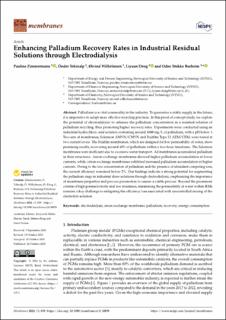| dc.contributor.author | Zimmermann, Pauline | |
| dc.contributor.author | Tekinalp, Önder | |
| dc.contributor.author | Wilhelmsen, Øivind | |
| dc.contributor.author | Deng, Liyuan | |
| dc.contributor.author | Burheim, Odne Stokke | |
| dc.date.accessioned | 2024-01-19T08:49:50Z | |
| dc.date.available | 2024-01-19T08:49:50Z | |
| dc.date.created | 2023-12-18T08:45:57Z | |
| dc.date.issued | 2023 | |
| dc.identifier.citation | Membranes. 2023, 13 (11), . | en_US |
| dc.identifier.issn | 2077-0375 | |
| dc.identifier.uri | https://hdl.handle.net/11250/3112689 | |
| dc.description.abstract | Palladium is a vital commodity in the industry. To guarantee a stable supply in the future, it is imperative to adopt more effective recycling practices. In this proof-of-concept study, we explore the potential of electrodialysis to enhance the palladium concentration in a residual solution of palladium recycling, thus promoting higher recovery rates. Experiments were conducted using an industrial hydrochloric acid solution containing around 1000 mg/L of palladium, with a pH below 1. Two sets of membranes, Selemion AMVN/CMVN and Fujifilm Type 12 AEM/CEM, were tested at two current levels. The Fujifilm membranes, which are designed for low permeability of water, show promising results, recovering around 40% of palladium within a two-hour timeframe. The Selemion membranes were inefficient due to excessive water transport. All membranes accumulated palladium in their structures. Anion-exchange membranes showed higher palladium accumulation at lower currents, while cation-exchange membranes exhibited increased palladium accumulation at higher currents. Owing to the low concentration of palladium and the presence of abundant competing ions, the current efficiency remained below 2%. Our findings indicate a strong potential for augmenting the palladium stage in industrial draw solutions through electrodialysis, emphasizing the importance of membrane properties and process parameters to ensure a viable process. Beyond the prominent criteria of high permselectivity and low resistance, minimizing the permeability of water within IEMs remains a key challenge to mitigating the efficiency loss associated with uncontrolled mixing of the electrolyte solution. | en_US |
| dc.language.iso | eng | en_US |
| dc.publisher | MDPI | en_US |
| dc.rights | Navngivelse 4.0 Internasjonal | * |
| dc.rights.uri | http://creativecommons.org/licenses/by/4.0/deed.no | * |
| dc.title | Enhancing Palladium Recovery Rates in Industrial Residual Solutions through Electrodialysis | en_US |
| dc.title.alternative | Enhancing Palladium Recovery Rates in Industrial Residual Solutions through Electrodialysis | en_US |
| dc.type | Peer reviewed | en_US |
| dc.type | Journal article | en_US |
| dc.description.version | publishedVersion | en_US |
| dc.source.pagenumber | 0 | en_US |
| dc.source.volume | 13 | en_US |
| dc.source.journal | Membranes | en_US |
| dc.source.issue | 11 | en_US |
| dc.identifier.doi | 10.3390/membranes13110859 | |
| dc.identifier.cristin | 2214602 | |
| cristin.ispublished | true | |
| cristin.fulltext | original | |
| cristin.qualitycode | 1 | |

